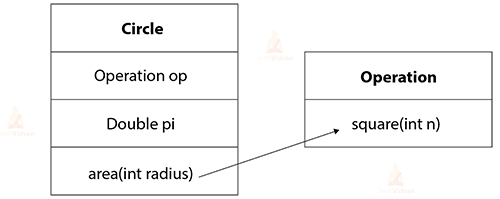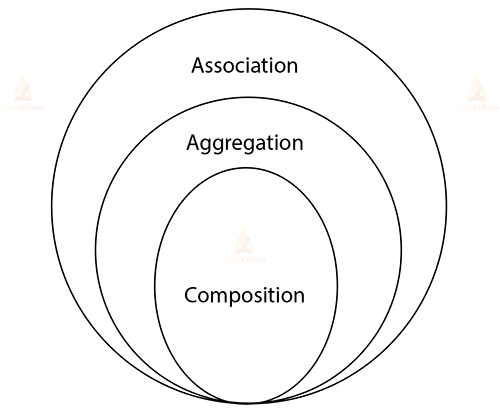Aggregation In Java
Aggregation is a key idea in the field of Object-Oriented Programming and allows for the development of intricate interactions between objects in Java. As a class, you’ll be able to simulate situations from the real world. The “part” or component, which makes up the “whole” or container, is made up of or contains instances of a different class. Based on this relationship, modular, reusable, and maintainable software systems are produced as a result.
What is aggregation in Java?
- When a reference to a distinct item B appears in object A, or if it is conceivable to claim that object A shares HASA with another object B, object A is referred to as an aggregation.
- Aggregation aids in the reuse of the code. The Object B’s utility functions could
Example:
Public class Speed{}
Public class Techvidvan{}
public class Van extends Techvidvan {
private Speed sp;
}
- Here, the speed category Van HASA Speed was displayed. Being able to reuse the Speed class across different applications is made possible by not having to include the full Speed-related code inside the Van class.
- When using the ObjectOriented functionality, users don’t have to worry about which object is actually functioning.
- To do this, the Van class conceals the implementation’s specifics from Van class consumers.
- In essence, users will ask the Van class to carry out a given task, and if it is carried out independently or in conjunction with another class, it will execute that work.
- This idea of including an object to complete a task is known as aggregation.
Why Do We Use Aggregation?
- As you mentioned, the term “aggregation” is used to refer to an entire collection of objects.
- Although that is the program’s main objective, there is another crucial advantage: it makes it simpler for us to recognize specific components so that we can be referred to as a whole.
- Each item can be listed by its index using the aggregation process to get a collection of sorted objects. If true, it’s a brilliant idea.
When use Aggregation?
- When there is no isa relationship, code reuse is also best achieved by aggregation.
- Only if a relationship is ongoing in relation to the object concerned throughout its lifetime should inheritance be used, or aggregation would have been more appropriate.
Learning the most important example of aggregation:
The employee has an address object in this example that contains its own info, such as city, state, country, etc. In such case, the relationship is Employee HAS-A address.
Aggregation Examples
In addition to arrays, there are a number of aggregation mechanisms used by programming languages.
How does data aggregation help?
- Aggregation platforms are responsible for collecting, processing and even presenting data.
- It is a key part of data integration. Aggregations help to aggregate data from different sources as well as from different heterogeneous and diverse sources.
- This will make the information more valuable.
- Data sourced from the best data integration platforms can be tracked to create an audit trail. You can go back in time from where the data was collected.
- It should be noted that summary information is not limited to numbers. For this purpose, data aggregation can be done manually or with software specifically designed for this purpose.
What are the steps in data aggregation?
- To achieve database aggregation, you need to have a data integration platform that helps gather data from more than one source.
- The next step is data processing for data enrichment. We have reached the stage where data is aggregated.
- Statistical analysis is performed here for the latest information.
Why data aggregation is so useful:
- Identifying the avalanche of information in the age of big data is not as simple as it seems.
- Data aggregation can be useful in this context.
- Aggregation collects data from different sources and consolidates all this information in one place.
- Data aggregation software tools are relied upon by companies that need to gain market intelligence.
The following tools can be used to perform these activities:
- Data extraction- This means that in order to meet the needs of a particular business, the appropriate data should be targeted or isolated from the aggregated data.
- Modification- Edit or transform data to conform to a prescribed format for analysis.
- Data visualization and analysis–This combined data can be used to develop business intelligence or guide decision-making once it is analyzed. With these metrics, you can easily evaluate where improvements are needed in your business.
Consider a restaurant as an example. QuickDining may use competitive research, price tracking, market intelligence, average order times and other data it collects through the data integration platform for its own benefit.
In this use, data aggregation is a bonus for business intelligence. Comprehensive aggregated data can help leaders make informed decisions. It is an effective way for companies to gain critical insight into their customers.
Combining data from disconnected, siled sources like social media, your CRM, and even web analytics allows businesses to gain deep insight.
Benefits of raw data aggregation:
- It is very difficult to work with large amounts of raw data without a coherent format.
- And it doesn’t provide any quantifiable information, so it won’t help your business.
- In contrast, aggregated data tells you a story in which you are the main character.
Conclusion
Let’s do it again. In short, aggregation is the process by which we aggregate everything into one. When we describe a group of items in general and an individual piece as part of a whole, we use aggregation. There are many examples of aggregation in C programming languages.


